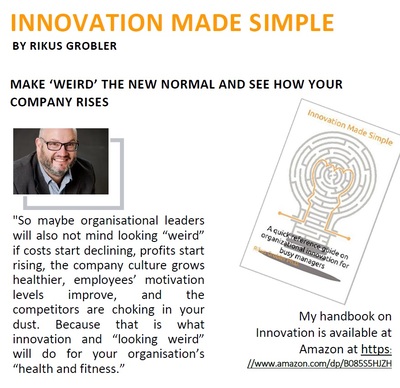
Crowdsourcing part II – a strategy to find the best ideas and solutions

By Rikus Grobler, www.nis.co.na, [email protected].
In the previous article, I discussed crowdsourcing as an innovation methodology. Although there are different ways to apply crowdsourcing in business, I am focusing on crowdsourcing for solution finding, i.e., using the crowd to solve a complex problem or generate creative ideas.
In brief, the process works like this: A business posts a challenge on the Internet, the “crowd” is recruited to work on the challenge, the crowd organises itself into teams, the teams compete to provide the best answer for the challenge, the business picks the solution they prefer, and the winning team is compensated.
Finding quality solutions
Usually, when I talk about crowdsourcing, the first question that gets asked is, why would people want to participate if it is not their problem to solve? It is an essential question because primarily crowdsourcing campaigns must be designed in such a manner as to solicit quality solutions. You do not want your crowdsourcing efforts to become just another suggestion box with a lot of the “same old, same old” ideas. Quality solutions come from attracting the “right” people, i.e., people with the required skillsets and motivation to solve a problem. How do you find them? As always, I turned to the research.
Oguz Acar conducted a study to determine people’s “why” for participating in crowdsourcing campaigns and found that crowd members differ greatly in terms of why they participate.
Some take part because they genuinely love creative problem-solving (what’s called “intrinsic motivation”). Others participate because they want to learn new things (“learning motivation”), make a positive impact on others (“pro-social motivation”), or be part of a social community (“social motivation”).
Not surprisingly, some members focus predominantly on winning the prize money or other benefits such as recognition and better career prospects (“extrinsic motivation”). Acar also concluded that these motivations have different effects on solution quality. Intrinsic (people who genuinely love creative problem-solving) and extrinsic (people who want to win the prize money or get recognition) motivations were associated with higher-quality solutions. In contrast, learning and pro-social motivations were negatively correlated to solution quality. Social motivation was not a significant predictor of the quality of ideas.
Basically, this means that to avoid a flood of useless ideas, businesses should consider designing their crowdsourcing initiatives in a way that encourages those with intrinsic and extrinsic motivation, while making pro-social and learning benefits less salient.
While the concept of crowdsourcing may be simple, finding great ideas and solutions isn’t as easy as just asking customers and fans for their best ideas. There is some method in the madness, and to be effective, a crowdsourcing project also needs the following elements:
1. A well-defined scope – respondents need to know exactly what is required in terms of a suggested idea or solution.
2. Comprehensive background information – respondents may need access to technical data before they can make a submission.
3. A clear preferred format for submissions.
4. A defined deadline for submissions.
5. The criteria on which submissions will be evaluated, and
6. The prize and how it will be awarded.
You also need to decide whether you want to target a large group of people (e.g., through big public social networks like Facebook or Twitter) or a specific group with highly-developed skills and experience (e.g. through specific online platforms).
Next Time
I have now dealt with Open Innovation and Crowdsourcing as innovation methodologies. In the next delivery, I will look at Six Sigma as an innovation methodology. Love it or hate it, Six Sigma has stood the test of time in the world of continuous improvement, and it serves a purpose.
I conclude with a quote from Julie Israel: “Creative people do not see things for what they are; they see them for what they can be.”
Click on the thumbnail below to order Dr Grobler’s e-book on Innovation from Amazon.













































